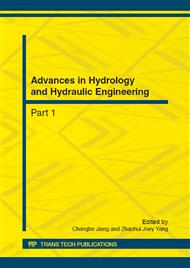p.970
p.974
p.981
p.985
p.989
p.998
p.1004
p.1009
p.1015
Numerical Simulation on Hazardous Area Distribution after Gas Outburst in Coal Uncovering Construction of Hydropower Station
Abstract:
The dynamic risk of underground cavities after gas outburst in coal uncovering construction of hydropower station was emphatically analyzed. The tunnel construction conditions in Xiangjiaba hydropower station were taken as an example. Based on the computational fluid dynamics theory and gas outburst theory, this paper used the ANSYS CFX CFD code to model the gas diffusion after gas outburst. The space-time characteristics of underground cavities dynamic risk were analyzed. The results show that the danger area ranges of gas explosion and asphyxia reach respectively the maximum value at about 140s and 50s. The influence range and duration of the former are significantly higher than the latter. The direction of hazardous area movement is mainly consistent with the air flow direction. ANSYS CFX simulation can visually display dynamic risk of underground cavities, and has a good prospect in gas hazard prevention in hydraulic and hydroelectric engineering.
Info:
Periodical:
Pages:
989-997
Citation:
Online since:
October 2012
Authors:
Price:
Сopyright:
© 2012 Trans Tech Publications Ltd. All Rights Reserved
Share:
Citation:


